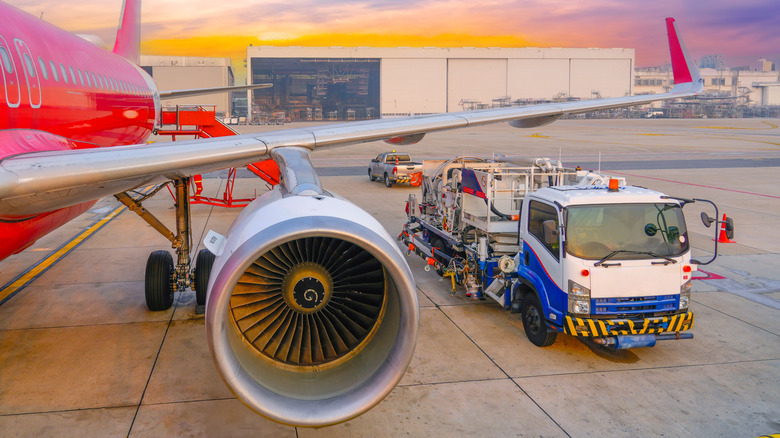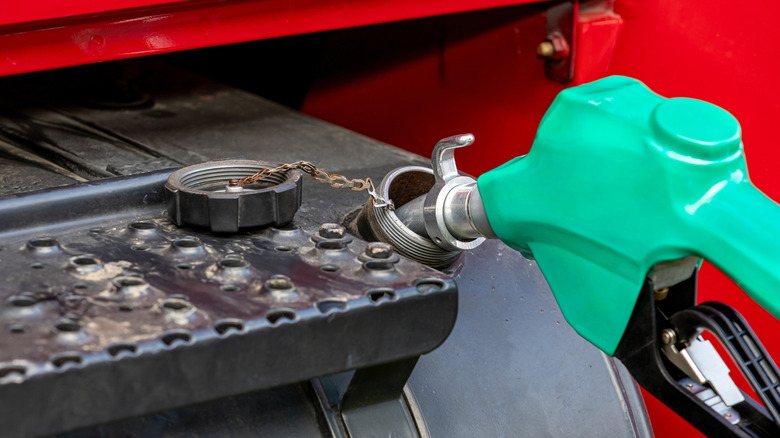Can Jet Fuel Be Put Into A Diesel Engine? (And What Happens If It Is?)
We've all thought about what would happen when you pour jet fuel into a diesel engine. Will it work or lead to immediate catastrophic failure, perhaps even an explosion? Planes are among the most fascinating vehicles today, from the ability to lift and travel through the sky to the immense power that their massive jet engines are known to produce. One of the main factors that makes them so powerful is the fuel many of them use: jet fuel.
This concoction is unique in that it's mainly used for aircraft with turbine engines, think turbofans and turbojets. It has unique properties that make it excel in its field, such as a low freezing point and being kerosene-based. But what would happen if you used it in a vehicle's diesel engine? Well, first of all, your engine wouldn't blow up. In fact, it would turn on and run, though not as optimally. However, since the fuel is highly specialized for aircraft, with different compositions like a higher cetane count and being thinner than diesel, it would damage your diesel engine in the long run. Let's talk about it.
Jet A has a lower energy density per gallon
Some of the most common jet fuels in the U.S. are Jet A and Jet B fuels, each serving a different purpose depending on the atmospheric temperature at which the plane is flying. The first, Jet A, is recognized by its freezing point of −40 degrees Fahrenheit and a flash point of 100 degrees Fahrenheit. The second, Jet B, has a lower freezing point of -97 degrees Fahrenheit. While Jet A is predominantly kerosene-based, Jet B is a blend of gasoline and kerosene. Its lower freezing point makes it ideal for frigid regions like Alaska, where Jet A would freeze. However, despite its seemingly appealing qualities, it is highly flammable, making it a last resort in cases where it is used.
Since Jet B contains gas and might actually end up burning down your whole truck, let's focus on Jet A as the most suitable fuel for your diesel engine experiment. Compared to diesel, Jet A has a lower energy density per gallon at 43.02 megajoules per kilogram, similar to diesel, but with a much lower freezing point, making it suitable for high-altitude and long-distance flights. It can also contain corrosion inhibitors and anti-icing agents, depending on the needs, which further enhance its effectiveness as an aircraft fuel. In contrast, diesel has a higher energy density that is more in line with the demands of a vehicle engine, and replaces the anti-icing inhibitors with lubrication agents. Diesel is also safer to handle because of its higher flash point and is more viscous than Jet A fuel.
Using a lubricant might help stall some of the jet engine's negative effects
Jet fuel comes with properties such as higher cetane numbers, which, granted, you could increase in your diesel through cetane boosters. But in jet fuel, the number is more in line with what is considered ideal for the massive engines that power aircraft, which translates to too high for road use. A higher cetane number than recommended will ultimately harm your engine. Additionally, due to its thin nature, Jet A may not provide sufficient lubrication for your engine during use, unlike diesel. Its higher burning temperature will also put more strain on your engine than diesel does.
However, if you still insist on using jet fuel for your diesel engine, you can expect lower efficiency while using it. Long-term use, however, will result in problems such as poor fuel filtration and fuel pump wear. You could circumvent some of these issues by adding a lubricant to the jet fuel, which might help reduce its impact on your diesel engine.


